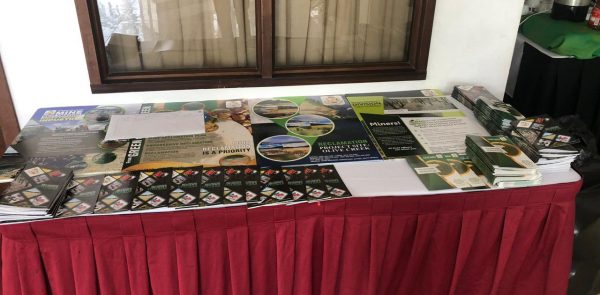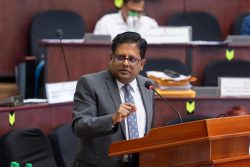The Guyana Geology and Mines Commission (GGMC) has in the past three years ensured the reclamation of over 40 acres of land previously used for mining and has spent approximately $100 million on the process, according to Commission-er Newell Dennison.
Dennison was speaking at an information session yesterday morning on mainstreaming the reclamation of mining lands.
He pointed out that so far they have been able to reclaim 44 acres (17 hectares) of previously mined land through their reclamation process and other associated activities at Dakoura and Kara, Linden; Olive Creek, Mazaruni; and Mahdia and Saint Elizabeth, Potaro-Siparuni. Over the three years that they have been engaged in the reclamation project, the Commission has expended over $100 million.

The locations include two old bauxite mining sites and four former gold mining sites.
“Let us hear of the lessons learned for the continuation of reclamation in the mining cycle, let us share knowledge and insights and let us accept that the cost of being ignorant and nonresponsive to this environmental need, the more costly it will be down the road. While we continue in our education and awareness campaign in support of the physical reclamation, we must not lose sight of the facts that reclamation is the law,” Dennison said.
Despite the cost and the responsibility for reclamation being that of the miner/operator, Dennison noted that the GGMC is committing, as a priority, to maintain the thrust and energy of the activity.
He said the Commission as the regulator of the mining sector must convert its constituency, who sometimes do not always appreciate the positives of compliance with good environmental standards and best practices even though the long term value will outlast their short sighted resistance.
“We all together need to minimise and mitigate the impacts on the environment from mining and invest in the potential after-mining value chain,” Dennison added, while noting that the health and wellness effect, and social contract for mining could be under threat if the attitude of the sector undermines the good work and economic outlook on the landscape, which can become productive again.
Also speaking at the event was the head of the GGMC’s Environmental Department, Carlos Todd, who highlighted that reclamation has taken a backseat in the mining process despite it being a legal requirement.
“A part of reclamation is that the property holder is required to submit a reclamation and closure plan. You submit to GGMC for approval to say how you intend to reclaim the area after mining has ceased. It also requires for you to lodge an environmental bond but the whole issue of reclamation is that the responsibility is on the miner and not on GGMC to use the bond to do reclamation,” Todd explained.
He emphasised that the current bond requirement is not enough and there are studies currently being done to determine a more suitable figure that should be lodged.
Todd also noted that there is need for an attitudinal change to how the mining process is conducted since the cost for reclamation needs to be factored into any mining plan.
Reclamation includes earth works, softening of slopes and, in some areas, ensuring physical and chemical stability. The Commission also covers the waterways that may have been polluted or disturbed by nearby mining activity.
As part of the renewed reclamation thrust by the GGMC, the Commission will be seeking to educate and encourage the miners and other stakeholders on the reclamation process and the benefits, and to enforce the existing legislations.
According to GGMC Environmental Officer Godfrey Scott, they have found that some challenges include the limited and poor understanding and interpretation of the existing laws, which he said most stakeholders were unaware of, and the issue of compliance, which is compounded by the ignorance of the laws.
They have since built on the previous work that was done by the Special Land Use Committee of the GGMC and have established a multi-agency task force that includes the Guyana Lands and Surveys Commission (GLSC), the Office of Climate Change and the Ministry of Agriculture.
The issue of land reclamation has also become a priority in the Commission’s work programme and Scott said that the next step will be their education and awareness programme, which starts in August and will run through next year.










